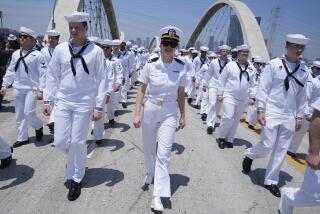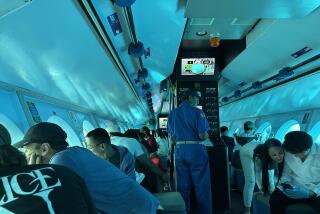Putting Zip Into VIPs’ Sub Rides
- Share via
Believe it or not, a ride in a U.S. Navy submarine can be duller than an elevator--no view and little motion. So captains often perform “angles and dangles,” running these undersea fighting machines at high speeds and steep angles to impress visiting civilian VIPs.
Retired Navy officials acknowledge that that may have figured in the collision last week of the nuclear-powered submarine Greeneville with a Japanese fishing vessel. Nine people, including four students, are lost at sea.
The Navy, determined to fend off budget cuts, has hosted an estimated 25,000 civilian guests over the last two years on West Coast vessels, including aircraft carriers and surface ships. These one-day and overnight trips are designed to woo journalists, politicians, business owners and other opinion makers. “It’s their Navy,” said Cmdr. Jack Papp.
Last year, for instance, 2,000 civilians boarded aircraft carriers on the West Coast to watch--and experience--the breathtaking precision of planes catapulted off rolling flight decks.
The Navy has for years hosted visitors on ships. But submarine visits became common in the mid-1990s, after decades of Cold War secrecy.
For these visitors, a rapid ascent to the surface is often a highlight of their submarine ride. Capt. Tom Kyle of the Pacific Fleet’s submarine force acknowledged that such emergency surfacing maneuvers, which are legitimate training exercises, are sometimes included in civilian tours. He was not on the Greeneville at the time of the collision.
Arthur Hollingsworth, an investment fund manager and chairman of the North Dallas Texas Chamber of Commerce, said his day aboard a submarine out of Fort Lauderdale, Fla., last year left him awe-struck by the sub and its crew, especially after the emergency surfacing maneuver.
“It happens very quickly, but you have no sense of being out of control,” said Hollingsworth. “I felt very safe all the time.”
The payoff for the Navy comes from what Hollingsworth describes as his newfound appreciation. “We in the civilian world have no idea the job these people are doing for us,” said Hollingsworth. “These are people of incredible quality.”
Commanding officers, eager to win such civilian support, often flaunt the abilities of their vessel and crew, according to retired military officers.
“The submarine captain does put on a show,” said retired submarine Adm. James Bush. Of all the maneuvers, the emergency surfacing, which the Greeneville did, is the most knock-your-socks-off dramatic, Bush said.
“To a certain extent, we want to show people the money they spent building submarines is worthwhile,” he said. “Whenever they take people aboard, they always do ‘angles and dangles.’ People who ride submarines are always impressed.”
That may explain, said Bush and others, why the Greeneville captain performed an emergency surfacing in a busy area of the Pacific--10 miles south of Honolulu--and why civilians were sitting at the controls.
“He’s showing off the capabilities of the ship in one of the most extreme ways you can,” said Bush.
Location of All 16 Civilians Not Known
Retired Vice Adm. Jack Shanahan said, “Showmanship and pride can get in the way of best judgment.” The presence of visitors, he and others said, may have interfered.
“Somehow the captain was distracted,” said Shanahan. “To be practicing that kind of maneuver . . . it was obviously being done for publicity purposes. It obviously wasn’t a training exercise because they weren’t training their own people.”
Shanahan speculated that visitors may have crowded the submarine’s control room. Navy officials have not said where all 16 civilians were at the time of the collision or released their names. Two were seated at controls with Navy supervision, officials have said.
The 362-foot Greeneville dove to about 400 feet, then rocketed to the surface on its Friday voyage, striking the 190-foot Ehime Maru shortly before 2 p.m. The Japanese training ship was carrying a crew of 35 sailors and students.
Submarines are supposed to use periscopes and sonar to make sure no other vessels are nearby before reaching the surface. Navy officials have not said whether those procedures were properly followed.
The emergency surface maneuver, which includes a steep pitch and the familiar “OOGAH” blast of the Klaxon horn, is generally considered a crowd pleaser. “It’s quite a ride,” said a South Florida soft-drink machine salesman who rode in a submarine off Florida last year.
The goal of the so-called Distinguished Visitor program, said Cmdr. Rob Newell, spokesman for San Diego-based surface ships, is to allow civilians to watch the daily operations of a vessel.
Most civilians, like those on the Greeneville, come aboard for a one-day jaunt. Visitors are required to pay for their own meals and lodging if they stay overnight.
Costs vary from ship to ship, says Cmdr. Chuck McWhorter of the West Coast’s Third Fleet. When a group goes from San Diego to Los Angeles on a planned trip this April aboard the Coronado, the Third Fleet’s flagship, each guest will be charged $20. They also will receive a cap and patch with the name of the ship, as well as a Continental breakfast and hot dog lunch.
Visitors aboard submarines get a tour of all areas except the nuclear propulsion section. The food is considered the best in the Navy.
In the control room, lighting is kept dim so that computer display screens shine brightly. Quarters are cramped; enlisted personnel sleep in racks about the size of large coffins; and every inch of space is utilized. Overnight visitors usually are given officers’ berths, luxurious for subs but only a fraction the size of a college dorm room.
During emergency dive drills, visitors hang on to the nearest chair or table to keep from falling. The Klaxon horn blasts and the captain bellows, “Dive! Dive! Dive!” Fire drills also are common. With sirens and flashing lights, sailors rush around, putting on gear and sealing off hatches. On a visit several years ago aboard one San Diego-based sub, a civilian shot a blank torpedo.
The Navy hopes the on-board experiences will win over civilians who are “active and influential in their community, business or government,” according to Navy policy. Reporters and editors from The Times, for example, have participated.
A 1989 directive by the chief of naval operations said taking civilians aboard must be “in the furtherance of continuing public awareness of the Navy and its mission.”
As part of the effort, public relations officers aboard individual ships often provide news releases and pictures of visitors on the vessels to local media. For submarines, Navy officials invite residents of the cities and states for which the boats are named. The Navy also encourages close ties between such “sponsoring” areas and the subs. Often, the mess deck is named for a local restaurant.
In 1999, the Pacific Fleet--which includes surface ships, submarines and aircraft carriers--took 11,674 civilian guests. The numbers have not been tallied yet for 2000, Navy officials said, but they will probably top 14,000.
In many cases, these trips convert skeptics into ardent supporters.
“It was awesome,” said Bob Griego, a Chula Vista school board member who spent a day aboard the aircraft carrier Constellation. “I came back a total believer in what those kids are doing for us. The long hours, the hard work, it’s unbelievable.”
Sheila McNeill, who runs a greeting card shop in Kings Bay, Ga., has taken two trips aboard submarines. “I learned how professional our submarine sailors are, how young they are, and all the difficult things they do. Everyone I know who has done one of these cruises has come back more patriotic, more energized and a great recruiter for the Navy.”
For the submarine community, such praise comes at a crucial time.
More Cuts in Sub Fleet May Be Coming
The number of fast-attack submarines had been reduced from a high of 98 during the Cold War to 55. There are plans to further reduce the fleet.
Submariners complain about the cutbacks, but critics say the submarine is a military relic that is too expensive and strategically ineffective in the post-Cold War world. The Bush administration, however, is expected to consider an urgent request from the Navy to increase, not decrease, the number of attack submarines.
Submariners, often known as Bubbleheads, believe that their own cloak of secrecy may have helped contribute to their dwindling numbers.
But following the breakup of the Soviet Union, submarine admirals have come to realize the value of a vigorous public relations effort.
Last year, the Navy held a year-long celebration of the submarine service’s 100th anniversary and stepped up efforts to bring civilians aboard.
Many submariners have embraced the program.
“Those are skippers who love what they do,” said Cmdr. Greg Smith, Navy spokesman at the Pentagon. “There is no shortage of ego in terms of showing off the capability of their boats and their crews.”
*
Times staff writer Maria L. La Ganga contributed to this story.
*
More Inside
Hinderance Aboard?: The Navy said the civilians on the Greeneville may have been a distraction. A14
More to Read
Sign up for The Wild
We’ll help you find the best places to hike, bike and run, as well as the perfect silent spots for meditation and yoga.
You may occasionally receive promotional content from the Los Angeles Times.






